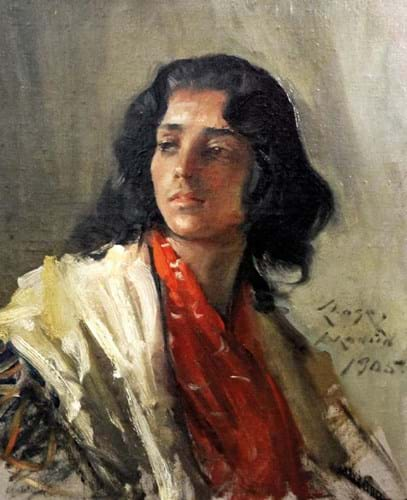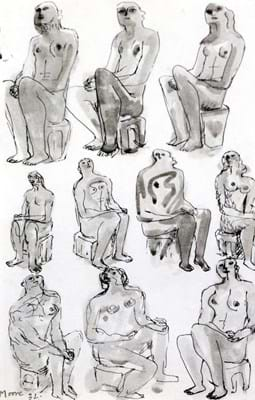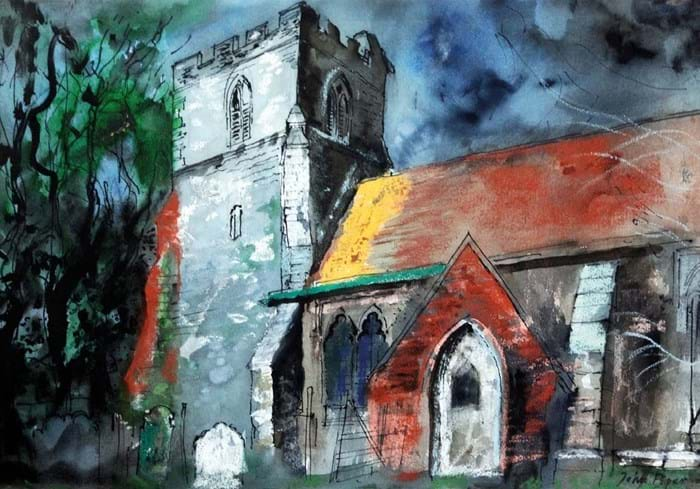An official First World War artist, he had lost all his possessions and most of his artwork when his own apartment in the slums of south London had been bombed in 1940.
By the time Spare was ‘fire-spotting’, he had become a recluse, making a living from drawing portraits in local pubs, creating talismans for fellow occult practitioners and selling his sketchbooks.
One of these sketchbooks, filled with strange Surrealist figures and forms in desolate landscapes executed in coloured pencils, turned up at Gorringe’s (21% buyer’s premium) in Lewes, East Sussex, on September 26, consigned from a private collection in Eastbourne.
Attached was a note: 35 drawings by A.O.S. Bought for £15. Nov 15th 1945 through Hannen Swaffer.
The ring-bound booklet contained 35 of these ‘automatic drawings’ – a process famously adopted by the Surrealists as a way to incorporate randomness and the subconscious into their drawings (but which Spare had been doing before the Surrealist movement came to England).
Brazilian collector
Separated and offered individually, all bar one was acquired by the same buyer, rumoured to be a Brazilian collector who has been amassing a number of Spare’s works.
The collection raised a bumper £94,500, although the buyer may well have secured the collection for less had the underbidder not turned his bidding from £100 increments into £1000 leaps on realising he was going to be outbid.
Mod Brit talent
The other stand-out collection in the sale was a group of works on paper from a deceased estate featuring art by notable Modern British talent.
The 13-lot group was acquired many years ago mainly from the Bohun Gallery in Henley-on-Thames.
All bar one lot – a slightly gloomy Stanley Spencer – got away. Among the top-sellers was a 14 x 21in (36 x 53cm) quintessential John Piper (1903-92) watercolour depicting St Dunstan’s church in Snargate near Romney Marsh in Kent. It was secured by the trade at £11,000 against a £2000-3000 estimate.
A bright and early work by Julian Trevelyan (1910-88) of the Tuscan landscape from 1959 bettered its £5000-7000 guide to sell for £8000. It had previously been exhibited at the artist’s retrospective at the Royal College of Art in 1998.
A grey wash over pen and black ink study from 1932 by Henry Moore (1898-1986) sold within estimate to the English trade at £7500. The 10 x 7in (25 x 18cm) single sheet depicted 10 sketches of his seated figures.
Outside the group, a Walking Man bronze by Elisabeth Frink (1930-93) took £20,000, against a £10,000- 15,000 estimate. The 11½in (29cm) high piece, numbered five, had been a gift from the artist to her son’s surgeon. The price is in line with another Walking Man bronze, cast in 1986, which sold at Bonhams London in November 2006 for £17,000.
Spanish becomes American

This 20th century portrait catalogued as ‘Spanish School’ was instead thought to be a work by the American painter William Merritt Chase and soared to £19,000 at Gorringe’s.
A 20th century portrait catalogued as ‘Spanish School’ was the unexpected star at Gorringe’s where it soared to £19,000.
Depicting a young woman, the 23 x 19in (58 x 48cm) oil on canvas (shown above) came to the Lewes saleroom from a local vendor who had inherited the work.
It bore an indistinct signature and was inscribed Madrid 1905 – the only clues auctioneer Clifford Lansberry had to go on.
“As it turned out, a few people clearly worked out who it was by. It’s thought to be a work by the American painter William Merritt Chase,” he said.
William Merritt Chase (1849-1916) is best known for his Impressionist landscapes and portraiture. He was responsible for establishing the Chase School of Art in New York.
A prolific artist and an early exponent of Impressionism, his best works have sold for over £1m at auction and are held in a number of American institutions. Chase also travelled widely and is known to have visited Spain in 1905.
Estimated at £500-800, the painting was secured by a buyer in Madrid who competed against US bidders and the UK trade.



















